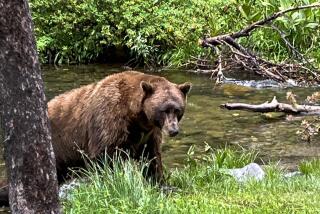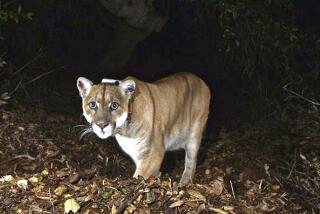It’s Cunning, It’s Hungry, It’s the Neighborhood Coyote
- Share via
It’s a scene Jag Saikumar is unlikely to forget. During a sunset stroll at an Irvine park, a coyote rushed from the bushes and attacked his 3-year-old son, Kaushik.
“He just charged. I barely saw him out of the corner of my eye,” Saikumar said.
The animal snapped at the boy’s right knee, the force from the charge knocking the child to the ground. It then lunged for the boy’s neck. “I was screaming, ‘Get out! Get out! Leave him alone!’” Saikumar recalled.
He yanked a slipper from his foot and threw it at the coyote, which snatched it and began chewing. “That was the window I needed, and I yelled to my son, ‘Run, baby, run!’”
The boy ran into his father’s arms; they backed away from the coyote. Police, responding to Saikumar’s cell phone call, shot and killed the animal. His son was treated for puncture wounds and had to endure a series of rabies shots. “I will never underestimate a wild animal again,” Saikumar said.
Though still rare, coyote attacks like the one on Kaushik Saikumar last year have increased alarmingly in Southern California’s urban fringes, wildlife experts say. More common are coyote sightings or calls from frantic pet owners telling animal control officers a coyote attacked their cat or small dog.
Last year, the state Department of Fish and Game recorded 17 coyote attacks on people in its vast southern region. Eight, like that on Saikumar’s son, resulted in injuries requiring hospitalization. In 2000, there were only three attacks.
This year, there had been no reported attacks until May 11. A man walking an 80-pound dog in the canyons in the Hollywood Hills was stalked and then chased by five coyotes, said Mervin Hee, Fish and Game patrol chief for the southern region, which includes Santa Barbara, Ventura, Los Angeles, Orange and San Diego counties. The man was not injured in the attack.
“A lot of the things that happened last year happened after coyote pups were coming out of the den with the mother in late spring. She’s desperately hungry and in need of protein. It seems we’re going through that same pattern again,” he said.
Hee said he would like to hire more wardens, but with the state budget deficit, his resources are limited. Instead, starting next month, Fish and Game will recruit volunteers, first in San Diego, then in Orange County and north to Ventura, to receive a crash course in coyote behavior--essentially Coyote 101. The volunteers will share what they learn with the public at town hall meetings, homeowners associations, community centers and even door to door.
Without realizing it, Hee said, people have created a welcome environment for the scavenging coyote: pet food left outdoors; full trash cans left uncovered; people feeding wild animals; pets allowed to roam freely at night; landscaping that offers excellent cover. In short, people have created a better habitat for coyotes than nature has, Hee said. This year’s drought is expect to compound the problem. The lack of rain has pushed small rodents and other prey into residential areas, where they find vegetation and other food sources. Right behind is the coyote.
“The wild lands can’t support them,” said Doug Updike, a senior wildlife biologist for Fish and Game. “The coyotes ... are faced with a choice: They can move or die.”
And since coyotes are nothing if not adaptable, they move. In recent months, coyotes have been sighted as far west as Huntington Beach.
“Wile E. Coyote is named that way for a reason,” Updike said.
“Coyotes are smart, very smart,” agreed Rick Parmer, a Fish and Game supervising naturalist for the central coast region in Napa.
Which means that to change the behavior of urban coyotes, people have to change their own behavior. Killing a nuisance coyote is not the answer because it will just be replaced by another coyote, Hee said.
Though no one has done surveys, Hee said, experts believe that “we have more coyotes in the urban area than in the wild. Look around you. There are ample food sources, water, everything they need. The food sources are here because we’re careless.”
The increasing number of conflicts prompted Fish and Game to issue a statewide warning last week alerting people to the dangers of coyotes in urban areas and explaining how to deal with them. Among the more dramatic attacks in 2001 recorded by Fish and Game:
* Dec. 15--A San Gabriel father and his 3-year-old daughter were leaving their home. As the father turned back toward the frontdoor, a coyote grabbed the child by the shoulder and head and pulled her out to the street. The child suffered minor injuries.
* Oct. 2--Three children were attacked while on lunch break at a San Clemente elementary school. One child was bitten on the back of the head, another was scratched on the back and arm, and the third was knocked to the ground.
* June 22--A 7-year-old girl and her younger brother were playing about 7 p.m. in the backyard of a Northridge home when a coyote entered the yard and attacked the girl. The coyote released the girl after being hit on the head with a chair.
* April 23--A Pomona woman was working in her backyard when a coyote attacked her dog. She grabbed an ax handle and hit the coyote four or five times to rescue her pet. She was scratched by the coyote in the fight.
Wardens say coyotes that find their way into neighborhoods need their behavior altered, not reinforced. “Make loud noises, spray them with water. We’ve looked at novel ideas, from shooting them with paint-ball guns to rubber bullets,” Parmer said.
It’s not that coyotes have become more aggressive, but they’ve learned that humans in an urban or suburban setting do not pose a threat to them. “In the wild, when a coyote sees a human, they take off. But coyotes are very adaptable,” said Lt. Angel Raton, a Fish and Game warden based in Orange County. “They learn that most humans are not a threat and learn to tolerate humans. Here, they don’t have that fear.”
Trapping and relocating urban coyotes away from suburbia isn’t the answer, Hee said. “You can’t relocate them because you’re just relocating a problem. You can’t take them off to the desert or wilds because they won’t be able to hunt, because they’re pack animals and a new pack won’t accept the new member.”
Once a coyote has attacked someone, it is hunted and killed either by police or by Fish and Game officials. Sometimes, the animals are trapped and killed. Coyotes are not a protected species and can be destroyed by Fish and Game wardens merely for displaying aggressive behavior.
Updike, the Fish and Game biologist, said he believes that the incursion problem may worsen before it gets better.
“It may take a good rainy season combined with changing our behavior,” he said. “Even one dog’s pet dish left outdoors could mean the difference with one coyote surviving in an urban area or not.”
More to Read
Sign up for Essential California
The most important California stories and recommendations in your inbox every morning.
You may occasionally receive promotional content from the Los Angeles Times.










